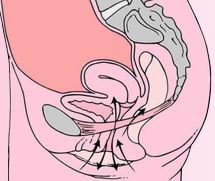Advice on Post-Natal Pelvic Floor Issues
I need some advice about the SHOULD NOT Do’s for a person in treatment for pelvic floor physio. I am working with a health care professional couple privately. They have a new baby (6 months)….
I’ve done some research online and it looks like any pose that puts pressure on the pelvic floor should be avoided:
i.e., boat, half boat pose, garland pose, plank, wide legged stretch, chattering, lotos pose (on tummy)
fish pose crow pose.
For Shavasana: I offered reclining bound angle pose with blocks supporting at the top of the legs. When I got home I was wondering about that.
Is there anything else I should absolutely AVOID? Note: I told them I am not an expert on pelvic floor and that she should rely on her physio person to treat the pelvis floor concern.
How about lying on the back using straps to stretch legs out to the side (bent knee and arm on opposite side counter balancing)?

Answer from Justine
First things first – I need some more information on just what the problem is……she is in pelvic floor physio – does she have weakness in the pelvic floor or chronic contraction she can’t get to relax? Both are a problem! I’m going to assume weakness…….given the recency of her birth – but the chronic contraction is important to know as that can be quite painful and also create a myriad of problems. Secondly, if it is a weak pelvic floor, has their been any pelvic organ prolapse? Knowing the severity of the problem lets you know how much you can push in regards to strengthening….how close to the edge one can dance, so to speak.
I have some suggestions:
- Would they be open to allowing you to have a conversation with the physio….or at least share the exact diagnosis and what exercises have been prescribed to help the situation?
- The Savasana pose you offered isn’t necessarily a no-no (unless she feels discomfort!) – I would suggest propping the legs fairly high so she doesn’t feel a stretch, and she could practice 2 or 3 part exhale while in the pose – initiating the exhale by lifting the pelvic floor, pausing, then pulling the abs in from the pubic bone up (2 part) moving on to three part exhale, initiating by engaging the pelvic floor, pause (keep it engaged), pull abs in from pubic bone to belly button, pause, then continue to pull abs in from belly button to rib cage. Pause. Then, in both instances, soften belly from top down and then relax pelvic floor. That will not only focus on muscle engagement, but in bringing attention and prana to the whole pelvic area. That position also makes it a bit more work for the pelvic floor to engage….which is a good thing, unless it creates discomfort or discouragement – in which case, legs can be extended straight out over a bolster to make it easier for her to engage the pelvic floor.
- With chronic contraction…..engaging the pelvic floor would be an important first step in getting it to disengage….sounds weird, but often the muscles have to be engaged more in order for them to then release.
- If she is a runner……encourage her to stop until she gets this issue resolved.
You are spot on with your ideas of not putting pressure on the pelvic floor. I like your idea of the strap work, with the opposite knee bent to ease pressure.
I also want to offer a couple of resources you could use or share with your client – here is a workshop with Sherry:
https://yogajptv.vhx.tv/videos/bladder-part1-intro
If you could share what other info you have or could find out that would be great.
Aloha 🙂
Justine
Answer from Viki
Good advice from Justine. Really, when a woman has a baby she should take up to a year to slowly ease into work and exercise. I know it will be practically impossible to convince anyone to do that!
The trunk of your body is a canister- diaphragm, abs, back and pelvic floor. If you have to much pressure pushing down onto the pelvic floor this will cause problems. So you are right about no boat, chatturanga, etc. One really good resource is Julie Wieb. Check her out on Youtube and she mentions, however, that downward dog causes more pressure for some women than plank! So, you can never be sure how people use their body and distribute forces within it!
One of PF expert friends in NY spends most of her time rehabiliting women after child birth with breathing. That is where the bulk of time is spent. Get the full body experience of breathing and you will activate the floor. This, together with plenty restorative work will calm the nervous system to help unwind stress. A boon if you have issues down town!
Get your student to do gentle movement exploration to see what feels doable in her body. Probably avoid squats but doing squats on her back (or child’s pose) would be great ways to focus on the breath and draw up and forward from the perineum on the exhale. It’s a Kegel, in effect but make sure the inhale widens the perineum and doesn’t hold on. These days they call it a ‘reverse Kegel’.
Some people that are great to check out online are Julie Wieb, Sarah Ellis Duval, Isa Herrera and a lovely lady and fellow Franklin Method person Cheri Dostal Ryba. She has a number of lovely pelvic awareness videos on Vimeo and Youtube.
There’s much more I could go on about…also YES check out the online pelvic floor w/shop with Yoga Vista Academy if you haven’t seen it already. I give breathing techniques and a number of exercises.
Hope you have success. You sound like you are sensitive and on the right track!
Best,
Viki
Course: Pelvic Floor Health in the 50+ Population with Viki Boyko

